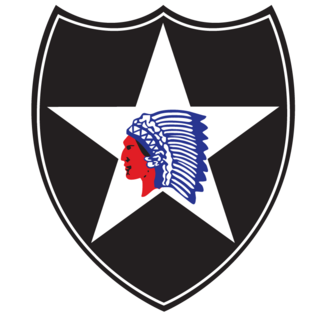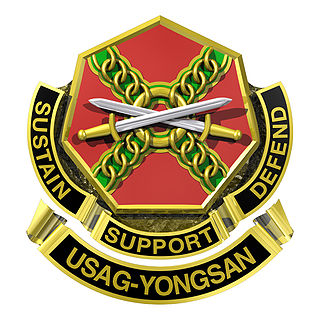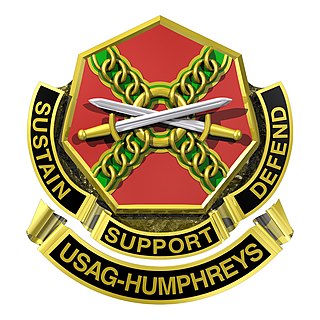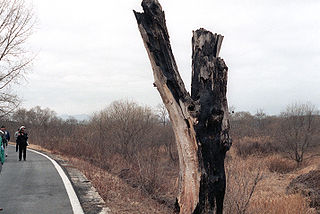
The 2nd Infantry Division ("Indianhead") is a formation of the United States Army. Since the 1960s, its current primary mission is the pre-emptive defense of South Korea in the event of an invasion from North Korea. There are approximately 17,000 soldiers in the 2nd Infantry Division, with 10,000 of them stationed in South Korea, accounting for about 35% of the United States Forces Korea personnel. Denoted the 2nd Infantry Division-ROK/U.S. Combined Division (2ID/RUCD), the division is augmented by rotational Brigade Combat Teams (BCTs) from other U.S. Army divisions.

Yongsan Garrison, meaning "dragon hill garrison", is an area located in the Yongsan District of central Seoul, South Korea. The site served as the headquarters for U.S. military forces stationed in South Korea, known as United States Forces Korea (USFK), and as United States Army Garrison Yongsan (USAG-Yongsan) until 2018, under the supervision of the U.S. Army's Installation Management Command Pacific Region. From 1910 to 1945 it served as headquarters for the Imperial Japanese Army in Korea.

The American Forces Network (AFN) is a government television and radio broadcast service the U.S. military provides to those stationed or assigned overseas. Headquartered at Fort George G. Meade, Maryland, AFN's broadcast operations, which include global radio and television satellite feeds, emanate from the AFN Broadcast Center/Defense Media Center in Riverside, California. AFN was founded on 26 May 1942, in London, as the Armed Forces Radio Service (AFRS).

The Eighth Army is a U.S. field army which commands all United States Army forces in South Korea. It is headquartered at the Camp Humphreys in the Anjeong-ri of Pyeongtaek, South Korea. Eighth Army relocated its headquarters from Yongsan to Camp Humphreys in the summer of 2017. It is the only field army in the U.S. Army. It is responsible to United States Forces Korea and United States Army, Pacific.

The Gyeongui Line is a railway line between Seoul Station and Dorasan Station in Paju. Korail operates the Seoul Metropolitan Subway service between Seoul Station and Dorasan Station.

Paju is a city in Gyeonggi Province, South Korea. Paju was made a city in 1997; it had previously been a county (gun).

Camp Humphreys, also known as United States Army Garrison-Humphreys (USAG-H), is a United States Army garrison located near Anjeong-ri and Pyeongtaek metropolitan areas in South Korea. Camp Humphreys is home to Desiderio Army Airfield, the busiest U.S. Army airfield in Asia, with an 8,124 feet (2,476 m) runway. In addition to the airfield, there are several U.S. Army direct support, transportation, and tactical units located there, including the Combat Aviation Brigade, 2nd Infantry Division. The garrison has an area of 3,454 acres (1,398 ha) and cost US$11 billion. Camp Humphreys is the largest U.S. overseas military base, housing some 500 buildings and amenities.
Camp Casey is a U.S. military base in Dongducheon, South Korea, 40 miles (64 km) north of Seoul, South Korea. Camp Casey was named in 1952 after Major Hugh Boyd Casey, who was killed in a plane crash near the camp site during the Korean War. Camp Casey is one of several U.S. Army bases in South Korea near the Korean Demilitarized Zone (DMZ). Camp Casey, Camp Hovey, and neighboring Camp Castle and Camp Mobile hold the main armor, 7th Division of a bridging engineer company as well, and mechanized infantry elements of the 2nd Infantry Division in South Korea. Camp Castle has been largely abandoned, with only a warehouse remaining. Camp Mobile was severely damaged during a flood in July 2011, and has been abandoned except for an unmanned aerial vehicle (UAV) company. Camp Casey spans 3,500 acres and is occupied by 6,300 military personnel and 2,500 civilians. There are plans for the relocation of most of the 2nd Infantry Division to Camp Humphreys which are underway with the latest estimate for completion being 2022. The Field Artillery Battalion remains for now at Camp Casey, while Camp Hovey is to be closed.

Camp Hovey is a United States Army military base in Dongducheon, Gyeonggi Province, South Korea. It was named after Master Sergeant Howard Hovey who was killed in action at Pork Chop Hill during the Korean War. The camp is adjacent to the larger Camp Casey connected by a road known as "Hovey Cut". The nearest city to Camp Hovey is Dongducheon, which is roughly 15 miles (24 km) from the Korean Demilitarized Zone (DMZ). There is a south gate into Camp Hovey from Gwangam-dong village.

The Korean axe murder incident was the killing of two US Army officers, Captain Arthur Bonifas and First Lieutenant Mark Barrett, by North Korean soldiers on August 18, 1976, in the Joint Security Area (JSA) in the Korean Demilitarized Zone (DMZ). The US Army officers had been part of a work party cutting down a poplar tree in the JSA.

The 607th Combat Weather Squadron of the U.S. Air Force has overall responsibility for planning, providing, and/or arranging weather support for the United States Army during armistice conditions in Korea. 607 CWS and elements of the US Navy and US Marines support the Republic of Korea Air Force (ROKAF) Weather Wing, Combined Meteorological and Oceanographic (METOC) Officer (CMO) and subordinate squadrons during exercises and contingencies. The 607 CWS commander is also the Joint METOC Officer (JMO) and the senior US METOC officer (SMO) for the Korean Theater of Operations (KTO).
Camp Coiner is a former 55-acre (220,000 m2) United States Forces Korea installation located on the northern part of Yongsan Garrison located in Seoul, South Korea. It was named after 2nd Lieutenant Randall Coiner assigned to the 3rd Battalion, 31st Infantry Regiment of the 7th Infantry Division who was posthumously awarded the Silver Star for actions taken in 1953 during the Korean War near the village of Sokkagae.

Operation Courageous was a military operation performed by the United Nations Command (UN) during the Korean War designed to trap large numbers of Chinese People's Volunteer Army (PVA) and Korean People's Army (KPA) troops between the Han and Imjin Rivers north of Seoul, opposite the Republic of Korea Army (ROK) I Corps. The intent of Operation Courageous was for US I Corps, which was composed of the US 25th and 3rd Infantry Divisions and the ROK 1st Infantry Division, to advance quickly on the PVA/KPA forces and reach the Imjin River with all possible speed.

ROK/US Combined Forces Command (CFC) is a joint warfighting headquarters comprising the Republic of Korea military and United States Forces Korea. It was established in 1978. During wartime it would serve as the operational command headquarters for all of the South Korean and U.S. ground, air, sea and special operations forces fighting on the Korean peninsula. Since November 2022 CFC has been headquartered at Camp Humphreys, in Pyeongtaek, Korea. Previously it was headquartered at Yongsan Garrison in Seoul.

Camp Jackson is a United States Army camp south of Camp Red Cloud and 20 miles south of the city of Uijeongbu at the throat of the Uijeongbu Corridor, on the National Highway 3 now in the far northern Dobong-gu suburb of Seoul. It was one of the smallest US military installations in South Korea. The camp was named after Private First Class George W. Jackson who was awarded the Silver Star during the Korean War.

The United States Army Installation Management Command Korea Region (IMCOM-K) was a military organization whose primary mission is to provide the United States Army in Korea the installation capabilities and services to support expeditionary operations in a time of persistent conflict, and to provide a quality of life for Soldiers and Families commensurate with their service. IMCOM-Korea was the Korean regional office of the Installation Management Command. IMCOM-K had its headquarters in Seoul, Republic of Korea on United States Army Garrison Yongsan. However, IMCOM Korea was deactivated and absorbed into IMCOM Pacific in 2011.

The U.S. Army Garrison Camp Long is located near Wonju, South Korea. This camp was named in honor of Sergeant Charles R. Long of the U.S. Army, who received the Medal of Honor for his actions nearby in 1951 during the Korean War. Sergeant Long was acting as a forward observer in Company M of the 38th Infantry Regiment, 2nd Infantry Division when he was killed in action.
Camp Page(캠프 페이지) also known as K-47 Air Base was a former US Army base located near Chuncheon, South Korea which was closed on 1 April 2005. It enclosed 157.2 acres in North Central South Korea, near Chuncheon City, 48 miles north of Seoul, in the Kangwon province. As of 5 February 2018, the only remaining structure on the site of the former Camp Page is the water tower. The site is being developed into an urban park.
Busan Citizens Park is a former Imperial Japanese Army base and United States Army camp located in the Busanjin District of the city of Busan, South Korea. The Camp occupying 133-acre (540,000 m2) of prime real estate was closed on 10 August 2006 and returned to the Busan city government. It was redeveloped under its current name and opened on 1 May 2014.
Camp Market is an installation of the United States Army, based on the Yongsan Garrison and it is situated in Bupyeong District, Incheon, South Korea. It is around halfway between Yongsan Garrison and the Port of Incheon, 30 miles to the west. The camp is not usually operated by U.S. Army divisions, except the 55th Military Police Company, which settled permanently in this camp. Unlike most Eight Army camps in South Korea, it is a supply depot. It is operated by civilian forces, mostly Korean nationals. It is now used as an Army & Air Force Exchange Service bakery and distribution Center.













